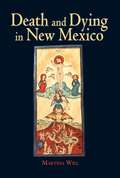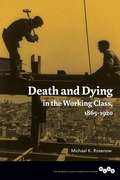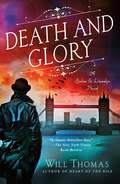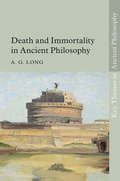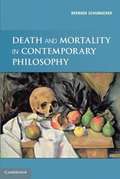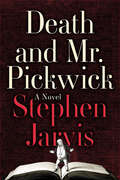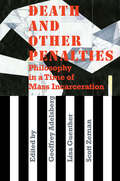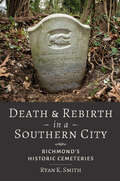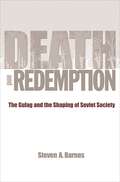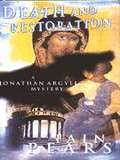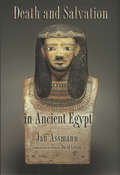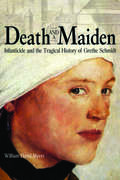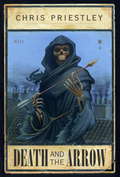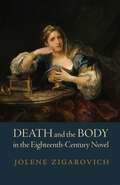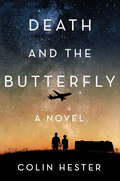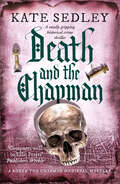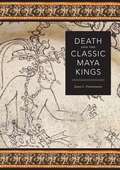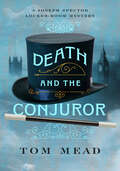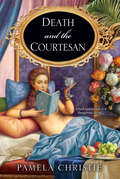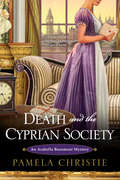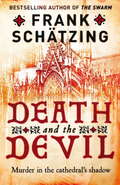- Table View
- List View
Death and Dying in New Mexico
by Martina WillIn this exploration of how people lived and died in eighteenth- and nineteenth- century New Mexico, Martina Will weaves together the stories of individuals and communities in this cultural crossroads of the American Southwest. The wills and burial registers at the heart of this study provide insights into the variety of ways in which death was understood by New Mexicans living in a period of profound social and political transitions.This volume addresses the model of the good death that settlers and friars brought with them to New Mexico, challenges to the model's application, and the eventual erosion of the ideal. The text also considers the effects of public health legislation that sought to protect the public welfare, as well as responses to these controversial and unpopular reforms. Will discusses both cultural continuity and regional adaptation, examining Spanish-American deathways in New Mexico during the colonial (approximately 1700–1821), Mexican (1821–1848), and early Territorial (1848–1880) periods.
Death and Dying in the Working Class, 1865-1920
by Michael K. RosenowMichael K. Rosenow investigates working people's beliefs, rituals of dying, and the politics of death by honing in on three overarching questions: How did workers, their families, and their communities experience death? Did various identities of class, race, gender, and religion coalesce to form distinct cultures of death for working people? And how did people's attitudes toward death reflect notions of who mattered in U.S. society? Drawing from an eclectic array of sources ranging from Andrew Carnegie to grave markers in Chicago's potter's field, Rosenow portrays the complex political, social, and cultural relationships that fueled the United States' industrial ascent. The result is an undertaking that adds emotional depth to existing history while challenging our understanding of modes of cultural transmission.
Death and Dynasty in Early Imperial Rome
by J. Bert LottThe founding of the Roman principate was a time of great turmoil. During the nascent stages of this change, there was an evolving sense of empire and inheritance. By bringing together a set of important Latin inscriptions, including the recently discovered documents concerning the death of Germanicus and trial of Calpurnius Piso, this book illustrates the developing sense of dynasty that underpinned the new monarchy of Augustus. Students can see the process by which monarchy of Roman Empire was established by examining contemporary official documents and also understand why some inscriptions were established permanently. It provides a historical commentary on the inscriptions that will be useful to students and scholars alike and supplies important technical help in understanding the production of documents and inscriptions. These technical explanations make it an excellent starting point for introducing students to Roman epigraphy.
Death and Glory: A Barker & Llewelyn Novel (A Barker & Llewelyn Novel #16)
by Will ThomasIn 1894, Cyrus Barker, London's premier enquiry agent, is entangled in a conspiracy to revive the American Civil War by prominent figures, long believed deceased.Private Enquiry agent Cyrus Barker, along with his partner Thomas Llewelyn, has a long, accomplished history - he's taken on cases for Scotland Yard, the Foreign Office, and even the crown itself, fulfilling them all with great skill and discretion. None of those cases, however, are as delicate and complicated as the one laid before him by a delegation of men who, thirty years before, fought for the Confederacy during the American Civil War. These men want to revive the Confederacy with a warship promised to the Rebels from the British Government in 1865. To get it now, they're threatening to reveal the long-secret treaty with the Confederacy. Barker is hired to use his connections to discreetly bring their threats to the Prime Minister.With a web of prominent, if secret, supporters throughout England ready to through their support to their efforts to wage war anew on the United States, the delegates are just waiting for the warship to begin their plans. But some of the men are not who they claim to be, and the American government has their own team watching, and waiting, for the right moment to take action.As this fuse on this powder keg of a situation grows ever shorter, it's up to Barker & Llewelyn to uncover the real identities and plans of these dangerous men.
Death and Immortality in Ancient Philosophy (Key Themes in Ancient Philosophy)
by A. G. LongDeath and immortality played a central role in Greek and Roman thought, from Homer and early Greek philosophy to Marcus Aurelius. In this book A. G. Long explains the significance of death and immortality in ancient ethics, particularly Plato's dialogues, Stoicism and Epicureanism; he also shows how philosophical cosmology and theology caused immortality to be re-imagined. Ancient arguments and theories are related both to the original literary and theological contexts and to contemporary debates on the philosophy of death. The book will be of major interest to scholars and students working on Greek and Roman philosophy, and to those wishing to explore ancient precursors of contemporary debates about death and its outcomes.
Death and Mortality in Contemporary Philosophy
by Bernard N. Schumacher Michael J. MillerThis book contributes to current bioethical debates by providing a critical analysis of the philosophy of human death. Bernard N. Schumacher discusses contemporary philosophical perspectives on death, creating a dialogue between phenomenology, existentialism, and analytic philosophy. He also examines the ancient philosophies that have shaped our current ideas about death. His analysis focuses on three fundamental problems: (1) the definition of human death, (2) the knowledge of mortality and of human death as such, and (3) the question of whether death is "nothing" to us or, on the contrary, whether it can be regarded as an absolute or relative evil. Drawing on scholarship published in four languages and from three distinct currents of thought, this volume represents a comprehensive and systematic study of the philosophy of death, one that provides a provocative basis for discussions of the bioethics of human mortality.
Death and Mr. Pickwick: A Novel
by Stephen JarvisDeath and Mr. Pickwick is a vast, richly imagined, Dickensian work about the rough-and-tumble world that produced an author who defined an age. Like Charles Dickens did in his immortal novels, Stephen Jarvis has spun a tale full of preposterous characters, shaggy-dog stories, improbable reversals, skulduggery, betrayal, and valor-all true, and all brilliantly brought to life in his unputdownable book.The Posthumous Papers of the Pickwick Club, featuring the fat and lovable Mr. Pickwick and his Cockney manservant, Sam Weller, began as a series of whimsical sketches, the brainchild of the brilliant, erratic, misanthropic illustrator named Robert Seymour, a denizen of the back alleys and grimy courtyards where early nineteenth-century London's printers and booksellers plied their cutthroat trade. When Seymour's publishers, after trying to match his magical etchings with a number of writers, settled on a young storyteller using the pen name Boz, The Pickwick Papers went on to become a worldwide phenomenon, outselling every other book besides the Bible and Shakespeare's plays. And Boz, as the young Charles Dickens signed his work, became, in the eyes of many, the most important writer of his time. The fate of Robert Seymour, Mr. Pickwick's creator, a very different story-one untold before now.Few novels deserve to be called magnificent. Death and Mr. Pickwick is one of them.
Death and Other Penalties: Philosophy in a Time of Mass Incarceration
by Lisa Guenther Scott ZemanMass incarceration is one of the most pressing ethical and political issues of our time. In this volume, philosophers join activists and those incarcerated on death row to grapple with contemporary U.S. punishment practices and draw out critiques around questions of power, identity, justice, and ethical responsibility.This work takes shape against a backdrop of disturbing trends: The United States incarcerates more of its own citizens than any other country in the world. A disproportionate number of these prisoners are people of color, and, today, a black man has a greater chance of going to prison than to college. The United States is the only Western democracy to retain the death penalty, even after decades of scholarship, statistics, and even legal decisions have depicted a deeply flawed system structured by racism and class oppression.Motivated by a conviction that mass incarceration and state execution are among the most important ethical and political problems of our time, the contributors to this volume come together from a diverse range of backgrounds to analyze, critique, and envision alternatives to the injustices of the U.S. prison system, with recourse to deconstruction, phenomenology, critical race theory, feminism, queer theory, and disability studies. They engage with the hyper-incarceration of people of color, the incomplete abolition of slavery, the exploitation of prisoners as workers and as “raw material” for the prison industrial complex, the intensive confinement of prisoners in supermax units, and the complexities of capital punishment in an age of abolition.The resulting collection contributes to a growing intellectual and political resistance to the apparent inevitability of incarceration and state execution as responses to crime and to social inequalities. It addresses both philosophers and activists who seek intellectual resources to contest the injustices of punishment in the United States.
Death and Rebirth in a Southern City: Richmond's Historic Cemeteries
by Ryan K. SmithThis exploration of Richmond's burial landscape over the past 300 years reveals in illuminating detail how racism and the color line have consistently shaped death, burial, and remembrance in this storied Southern capital.Richmond, Virginia, the former capital of the Confederacy, holds one of the most dramatic landscapes of death in the nation. Its burial grounds show the sweep of Southern history on an epic scale, from the earliest English encounters with the Powhatan at the falls of the James River through slavery, the Civil War, and the long reckoning that followed. And while the region's deathways and burial practices have developed in surprising directions over these centuries, one element has remained stubbornly the same: the color line. But something different is happening now. The latest phase of this history points to a quiet revolution taking place in Virginia and beyond. Where white leaders long bolstered their heritage and authority with a disregard for the graves of the disenfranchised, today activist groups have stepped forward to reorganize and reclaim the commemorative landscape for the remains of people of color and religious minorities. In Death and Rebirth in a Southern City, Ryan K. Smith explores more than a dozen of Richmond's most historically and culturally significant cemeteries. He traces the disparities between those grounds which have been well-maintained, preserving the legacies of privileged whites, and those that have been worn away, dug up, and built over, erasing the memories of African Americans and indigenous tribes. Drawing on extensive oral histories and archival research, Smith unearths the heritage of these marginalized communities and explains what the city must do to conserve these gravesites and bring racial equity to these arenas for public memory. He also shows how the ongoing recovery efforts point to a redefinition of Confederate memory and the possibility of a rebirthed community in the symbolic center of the South.The book encompasses, among others, St. John's colonial churchyard; African burial grounds in Shockoe Bottom and on Shockoe Hill; Hebrew Cemetery; Hollywood Cemetery, with its 18,000 Confederate dead; Richmond National Cemetery; and Evergreen Cemetery, home to tens of thousands of black burials from the Jim Crow era. Smith's rich analysis of the surviving grounds documents many of these sites for the first time and is enhanced by an accompanying website, www.richmondcemeteries.org. A brilliant example of public history, Death and Rebirth in a Southern City reveals how cemeteries can frame changes in politics and society across time.
Death and Rebirth of Seneca
by Anthony WallaceThis book tells the story of the late colonial and early reservation history of the Seneca Indians, and of the prophet Handsome Lake, his visions, and the moral and religious revitalization of an American Indian society that he and his followers achieved in the years around 1800.
Death and Redemption: The Gulag and the Shaping of Soviet Society
by Steven A. BarnesDeath and Redemption offers a fundamental reinterpretation of the role of the Gulag--the Soviet Union's vast system of forced-labor camps, internal exile, and prisons--in Soviet society. Soviet authorities undoubtedly had the means to exterminate all the prisoners who passed through the Gulag, but unlike the Nazis they did not conceive of their concentration camps as instruments of genocide. In this provocative book, Steven Barnes argues that the Gulag must be understood primarily as a penal institution where prisoners were given one final chance to reintegrate into Soviet society. Millions whom authorities deemed "reeducated" through brutal forced labor were allowed to leave. Millions more who "failed" never got out alive. Drawing on newly opened archives in Russia and Kazakhstan as well as memoirs by actual prisoners, Barnes shows how the Gulag was integral to the Soviet goal of building a utopian socialist society. He takes readers into the Gulag itself, focusing on one outpost of the Gulag system in the Karaganda region of Kazakhstan, a location that featured the full panoply of Soviet detention institutions. Barnes traces the Gulag experience from its beginnings after the 1917 Russian Revolution to its decline following the 1953 death of Stalin. Death and Redemption reveals how the Gulag defined the border between those who would reenter Soviet society and those who would be excluded through death.
Death and Restoration (Jonathan Argyll Art History Mysteries, Book #6)
by Iain PearsThe monastery of San Giovanni on Rome's Aventine hill has few treasures - only a painting doubtfully attributed to Caravaggio. So Flavia di Stefano of Rome's art police is surprised to receive a tip-off that a raid is being planned on the building. The raid takes place, but the thieves are disturbed and snatch the wrong painting, a curious icon of the Madonna, remarkable only for the affection in which it is held by the local population. Or is this what the thieves wanted all along? Does the legend of the icon's miraculous powers hold any clue? And who murdered the French dealer found in the Tiber soon afterwards? With the help of Jonathan Argyll, Flavia works her way through the intricacies of monastic and police politics and ends up by getting a bigger surprise than she could possibly have imagined. Iain Pears is the most exciting exponent of art-based crime, and Death and Restoration is his most intriguing and gripping novel yet.
Death and Salvation in Ancient Egypt
by Jan Assmann David Lorton"Human beings," the acclaimed Egyptologist Jan Assmann writes, "are the animals that have to live with the knowledge of their death, and culture is the world they create so they can live with that knowledge." In his new book, Assmann explores images of death and of death rites in ancient Egypt to provide startling new insights into the particular character of the civilization as a whole. Drawing on the unfamiliar genre of the death liturgy, he arrives at a remarkably comprehensive view of the religion of death in ancient Egypt.Assmann describes in detail nine different images of death: death as the body being torn apart, as social isolation, the notion of the court of the dead, the dead body, the mummy, the soul and ancestral spirit of the dead, death as separation and transition, as homecoming, and as secret. Death and Salvation in Ancient Egypt also includes a fascinating discussion of rites that reflect beliefs about death through language and ritual.
Death and a Maiden: Infanticide and the Tragical History of Grethe Schmidt
by William David MyersOn the feast of St. Michael, September 1659, a thirteen-year-old peasant girl left her familyÆs rural home to work as a maid in the nearby city of Braunschweig. Just two years later, Grethe Schmidt found herself imprisoned and accused of murdering her bastard child, even though the fact of her pregnancy was inconclusive and no infantÆs body was found to justify the severe measures used against her. The tale spiraled outward to set a defense lawyer and legal theorist against powerful city magistrates and then upward to a legal contest between that city and its overlord, the Duchy of Brunswick, with the cityÆs independence and ancient liberties hanging in the balance.Death and a Maiden tells a fascinating story that begins in the bedchamber of a house in Brunswick and ends at the court of Duke Augustus in the city of Wolfenb\u00fcttel, with political intrigue along the way. After thousands of pages of testimony and rancorous legal exchange, it is still not clear that any murder happened.Myers infuses the story of GretheÆs arrest, torture, trial, and sentence for \u201csuspected infanticide,\u201d with a detailed account of the workings of the criminal system in continental Europe, including the nature of interrogations, the process of torture, and the creation of a \u201ccriminal\u201d identity over time. He presents an in-depth examination of a criminal system in which torture was both legal and an important part of criminal investigations. This story serves as a captivating slice of European history as well as a highly informative look at the condition of poor women and the legal system in mid-17th century Germany. General readers and scholars alike will be riveted by GretheÆs ordeal.
Death and the American South
by Lorri Glover Craig Thompson FriendThis rich collection of original essays illuminates the causes and consequences of the South's defining experiences with death. Employing a wide range of perspectives, while concentrating on discrete episodes in the region's past, the authors explore topics from the seventeenth century to the present, from the death traps that emerged during colonization to the bloody backlash against emancipation and civil rights to recent canny efforts to commemorate - and capitalize on - the region's deadly past. Some authors capture their subjects in the most intimate of moments: killing and dying, grieving and remembering, and believing and despairing. Others uncover the intentional efforts of Southerners to publicly commemorate their losses through death rituals and memorialization campaigns. Together, these poignantly told Southern stories reveal profound truths about the past of a region marked by death and unable, perhaps unwilling, to escape the ghosts of its history.
Death and the Arrow
by Chris PriestleyA gripping historical mystery, full of 18th century atmosphere. Fifteen-year-old Tom lives in the murky city of London where he helps his father run a print shop. Among the customers is wise old Dr. Harker, a retired physician and seafarer, whose patient demeanour and fascinating tales endear him to Tom. Both Tom and Harker become intrigued by a murder in the city where the victim is pierced by an arrow and left holding an illustrated card of “Death and the Arrow. ” The mystery deepens after more “Death and the Arrow” victims are discovered, and Tom cannot rest until he has uncovered the truth behind the murders. This atmospheric venture into the eighteenth-century will fascinate and engage readers ten-years-old and up.
Death and the Body in the Eighteenth-Century Novel
by Jolene ZigarovichDeath and the Body in the Eighteenth-Century Novel demonstrates that archives continually speak to the period’s rising funeral and mourning culture, as well as the increasing commodification of death and mourning typically associated with nineteenth-century practices. Drawing on a variety of historical discourses—such as wills, undertaking histories, medical treatises and textbooks, anatomical studies, philosophical treatises, and religious tracts and sermons—the book contributes to a fuller understanding of the history of death in the Enlightenment and its narrative transformation.Death and the Body in the Eighteenth-Century Novel not only offers new insights about the effect of a growing secularization and commodification of death on the culture and its productions, but also fills critical gaps in the history of death, using narrative as a distinct literary marker. As anatomists dissected, undertakers preserved, jewelers encased, and artists figured the corpse, so too the novelist portrayed bodily artifacts. Why are these morbid forms of materiality entombed in the novel? Jolene Zigarovich addresses this complex question by claiming that the body itself—its parts, or its preserved representation—functioned as secular memento, suggesting that preserved remains became symbols of individuality and subjectivity. To support the conception that in this period notions of self and knowing center upon theories of the tactile and material, the chapters are organized around sensory conceptions and bodily materials such as touch, preserved flesh, bowel, heart, wax, hair, and bone. Including numerous visual examples, the book also argues that the relic represents the slippage between corpse and treasure, sentimentality and materialism, and corporeal fetish and aesthetic accessory.Zigarovich’s analysis compels us to reassess the eighteenth-century response to and representation of the dead and dead-like body, and its material purpose and use in fiction. In a broader framework, Death and the Body in the Eighteenth-Century Novel also narrates a history of the novel that speaks to the cultural formation of modern individualism.
Death and the Butterfly: A Novel
by Colin HesterFor readers of Michael Ondaatje and Chris Cleave, this sweeping multigenerational novel centered around endless heartbreak and enduring love features the intertwined stories of three women who transcend three tragedies of the twentieth century with the aid of the greatest love poet of all time: Pablo Neruda.London, England, September 1940. Thirteen–year–old Susan McEwan and her older brother, Phillip, a pilot, witness firsthand the initial Nazi bombing of civilian London. Weeks later, Phillip’s Sunderland bomber is shot down, and his family is wordlessly devastated.Toronto, Canada, the early 1980s. As a young couple struggles to survive the Reagan recession, the husband, Alexander Polo, is forced to take a job as a paperboy. When the wife, Julie, discovers she is pregnant, Polo must now confront his future head–on with his heart open.>Montana, the first days of September 2001. His wedding day overshadowed by the tragedy of 9/11, Jack Riordan discovers a magazine story written by Polo about Susan and airplanes and her love of the poems of Pablo Neruda.With humor and insight, Colin Hester explores how Susan, Polo, and Jack carry on—grieving the death of a child or the end of a marriage—in deeply felt and beautifully imagined prose.
Death and the Chapman (Roger the Chapman #1)
by Kate SedleyThe first in the Roger the Chapman mystery series.
Death and the Chapman: A totally gripping historical crime thriller (Roger the Chapman Mysteries)
by Kate SedleyOne man’s disappearance is another man’s destiny... The birth of a new medieval detective.The political situation in 1471 is complex and the war between the Yorkist and Lancastrian factions rages on. But for Roger the Chapman, who has recently given up a monk’s cell for freedom to be found peddling his wares on the open road, life goes on much as normal.Until, that is, he gets caught up in the strange disappearance of Clement Weaver, only son of a wealthy Bristol alderman. It seems that Clement is not the only one to have vanished without a trace from London’s Crossed Hands Inn...Roger’s interest is piqued and at the request of the alderman he sets off for the bustle and excitement of London, to find out just how Clement disappeared. It is a journey that carries him to a confrontation with the highest power in the land, and puts his life in mortal peril.The first of the gripping Roger the Chapman mysteries, the memoirs of an insatiably curious ex-monk who seeks out justice for the victims of medieval miscreants, ideal for fans of Graham Brack and Paul Doherty.
Death and the Classic Maya Kings
by James L. FitzsimmonsLike their regal counterparts in societies around the globe, ancient Maya rulers departed this world with elaborate burial ceremonies and lavish grave goods, which often included ceramics, red pigments, earflares, stingray spines, jades, pearls, obsidian blades, and mosaics. Archaeological investigation of these burials, as well as the decipherment of inscriptions that record Maya rulers' funerary rites, have opened a fascinating window on how the ancient Maya envisaged the ruler's passage from the world of the living to the realm of the ancestors. Focusing on the Classic Period (AD 250-900), James Fitzsimmons examines and compares textual and archaeological evidence for rites of death and burial in the Maya lowlands, from which he creates models of royal Maya funerary behavior. Exploring ancient Maya attitudes toward death expressed at well-known sites such as Tikal, Guatemala, and Copan, Honduras, as well as less-explored archaeological locations, Fitzsimmons reconstructs royal mortuary rites and expands our understanding of key Maya concepts including the afterlife and ancestor veneration.
Death and the Conjuror
by Tom MeadA magician-turned-sleuth in pre-war London solves three impossible crimes In 1930s London, celebrity psychiatrist Anselm Rees is discovered dead in his locked study, and there seems to be no way that a killer could have escaped unseen. There are no clues, no witnesses, and no evidence of the murder weapon. Stumped by the confounding scene, the Scotland Yard detective on the case calls on retired stage magician-turned-part-time sleuth Joseph Spector. For who better to make sense of the impossible than one who traffics in illusions? Spector has a knack for explaining the inexplicable, but even he finds that there is more to this mystery than meets the eye. As he and the Inspector interview the colorful cast of suspects among the psychiatrist’s patients and household, they uncover no shortage of dark secrets—or motives for murder. When the investigation dovetails into that of an apparently-impossible theft, the detectives consider the possibility that the two transgressions are related. And when a second murder occurs, this time in an impenetrable elevator, they realize that the crime wave will become even more deadly unless they can catch the culprit soon. A tribute to the classic golden-age whodunnit, when crime fiction was a battle of wits between writer and reader, Death and the Conjuror joins its macabre atmosphere, period detail, and vividly-drawn characters with a meticulously-constructed fair play puzzle. Its baffling plot will enthrall readers of mystery icons such as Agatha Christie and John Dickson Carr, modern masters like Anthony Horowitz and Elly Griffiths, or anyone who appreciates a good mystery.
Death and the Courtesan (An\arabella Beaumont Mystery Ser. #1)
by Pamela ChristiePamela Christie's sparkling historical mystery goes beyond the modest drawing rooms of Regency London in the company of the city's most esteemed and scandalous courtesan. . .Since the age of sixteen, Arabella Beaumont has been happily employed as a highly paid woman of pleasure. True, respectable ladies of the ton would never deign to call at Lustings, her delightful home. Then again, Arabella has no desire to make dreary small talk and sip tea when she could be enjoying the company of amusing, intelligent, and extremely generous gentlemen.But while Arabella's admirers are legion, she also has enemies. A paper knife stolen during one of her salons was discovered near the body of a former rival. Arabella was entertaining her wealthy benefactor on the night of the murder, but the engaged duke can't provide the alibi she desperately needs. It falls to Arabella and her resourceful sister, Belinda, to clear her good--or at least innocent--name. Utilizing all the talents in her arsenal, the irrepressible Miss Beaumont will endeavor to catch the real culprit, before the hangman catches up to her. . .Praise For Pamela Christie And Death Of A Courtesan"What a delicious and delightful tale! The Regency world is turned upside down--and much refreshed--by a decidedly unorthodox heroine. Pamela Christie writes with wit and verve, gifting readers with a vision of the period at once marvelously scandalous and oh-so tempting. I adore clever, spunky Arabella and look forward to her future adventures." --Sara Poole, author of The Borgia Mistress"A clever, funny, engaging read reminiscent of Fidelis Morgan's Unnatural Fire. Pamela Christie deftly combines the conventions of the Regency-era novel with the fast pace and careful attention to characterization found in the best modern historical mysteries." --Kate Emerson, author of The King's Damsel"With cleverness and humor, Pamela Christie brings to life a colorful world that would've been at the same time familiar and scandalous to Jane Austen and her readers." --Anna Loan-Wilsey, author of A Lack of Temperance"A smart, witty and thoroughly entertaining read! It reminds me of some of my favorite series on Masterpiece Theater." --Diane Haeger, author of I, Jane"A delectable treat for the historical mystery lover to savor. You will be left eager for Arabella's next adventure!" --Teresa Grant, author of The Paris Affair
Death and the Cyprian Society (An Arabella Beaumont Mystery #3)
by Pamela ChristieArabella Beaumont, courtesan, adventuress, and sleuth, romps her way through Regency London into a dangerous affair of blackmail. . .Arabella Beaumont is the fortunate possessor of one of England's most celebrated bodies--with a formidable business brain to match. Her latest venture: transforming a London hotel into a social club for courtesans. To afford the lavish renovations, Arabella needs her featherbrained friend Constance Worthington to repay the fortune she owes her. And now that Constance has a wealthy protector, Pigeon Pollard, she's finally good for the cash. Alas, the imprudent Constance has also been dallying with Lady Ribbonhat's footman, and a mysterious blackmailer is threatening to tell all. If Constance pays up, there will be no money left for Arabella's renovations;if she doesn't, the cuckolded Pigeon is bound to leave her penniless. But as the case escalates rapidly from extortion to murder, Arabella's life, as well as her fortune, hangs precariously in the balance. . .Praise For Death And The Courtesan"Saucy. . .the effervescent and free-thinking Arabella is a delightful heroine." --The Bellingham Herald"Historical mystery readers fond of arch and ribald takes on the genre will best appreciate Christie's debut." --Publishers Weekly
Death and the Devil
by Frank SchätzingCologne, 1260. The great cathedral, the most ambitious building in all Christendom, is rising above the city. In its shadow seethes a society in ferment: traumatised Crusaders returning from the Holy Land, religious tensions poised to explode into violence, a burgeoning merchant class that despises the old aristocracy and is determined to seize power.Against this backdrop Jacob the Fox, a flame-haired petty thief, witnesses a murder - the cathedral's architect, pushed to his death from the scaffold by a black-clad assassin. Soon Jacob is on the run, convinced the Angel of Death is on his trail, as the killer pursues him through medieval Cologne's seedy underworld. To survive he must uncover a vengeful conspiracy that threatens to tear the city apart and stain the sacred project with blood.
